HI5016 Assignment: Economic Impacts of International Labor Mobility
VerifiedAdded on 2023/06/04
|16
|3189
|287
Report
AI Summary
This report provides a detailed analysis of the economic impacts of international labor mobility, a significant feature of globalization. It examines the effects of both immigration and emigration on sending and receiving nations. The report explores the theoretical context using labor market models, discussing how labor mobility influences wages, employment, and productivity. It investigates the effects on receiving nations, considering factors such as skill matching, fiscal balance, and technological progress. The report also analyzes the impacts on sending nations, including the effects of brain drain and the benefits of remittances. Statistics related to international labor mobility are included. The analysis covers various aspects, including push factors for migration, the role of remittances, and the impact on wages and employment in both origin and destination countries. The research critically evaluates economic gains and losses for both sending and receiving nations, supported by relevant empirical evidence, concluding with a balanced assessment of the complex consequences of international labor mobility.
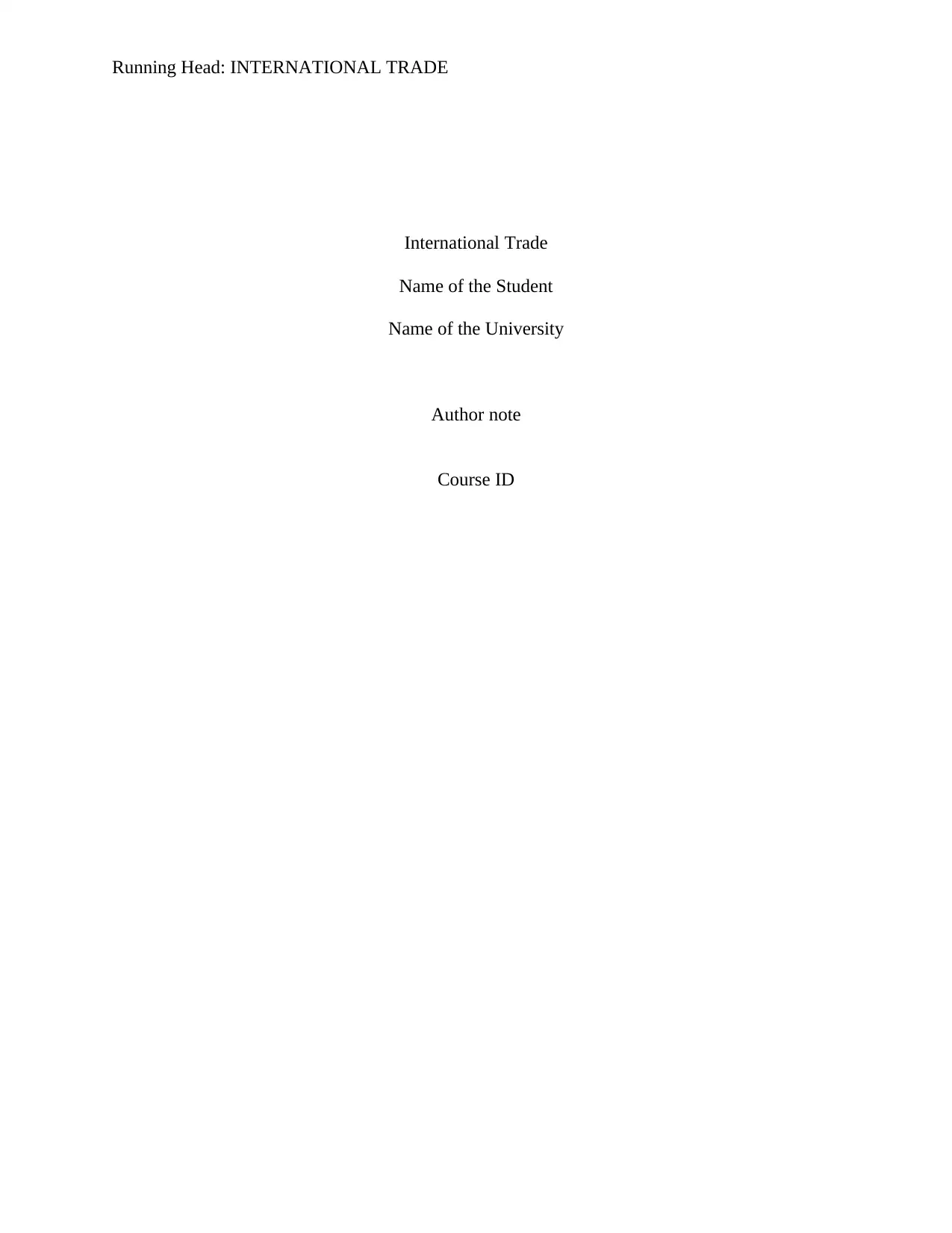
Running Head: INTERNATIONAL TRADE
International Trade
Name of the Student
Name of the University
Author note
Course ID
International Trade
Name of the Student
Name of the University
Author note
Course ID
Paraphrase This Document
Need a fresh take? Get an instant paraphrase of this document with our AI Paraphraser
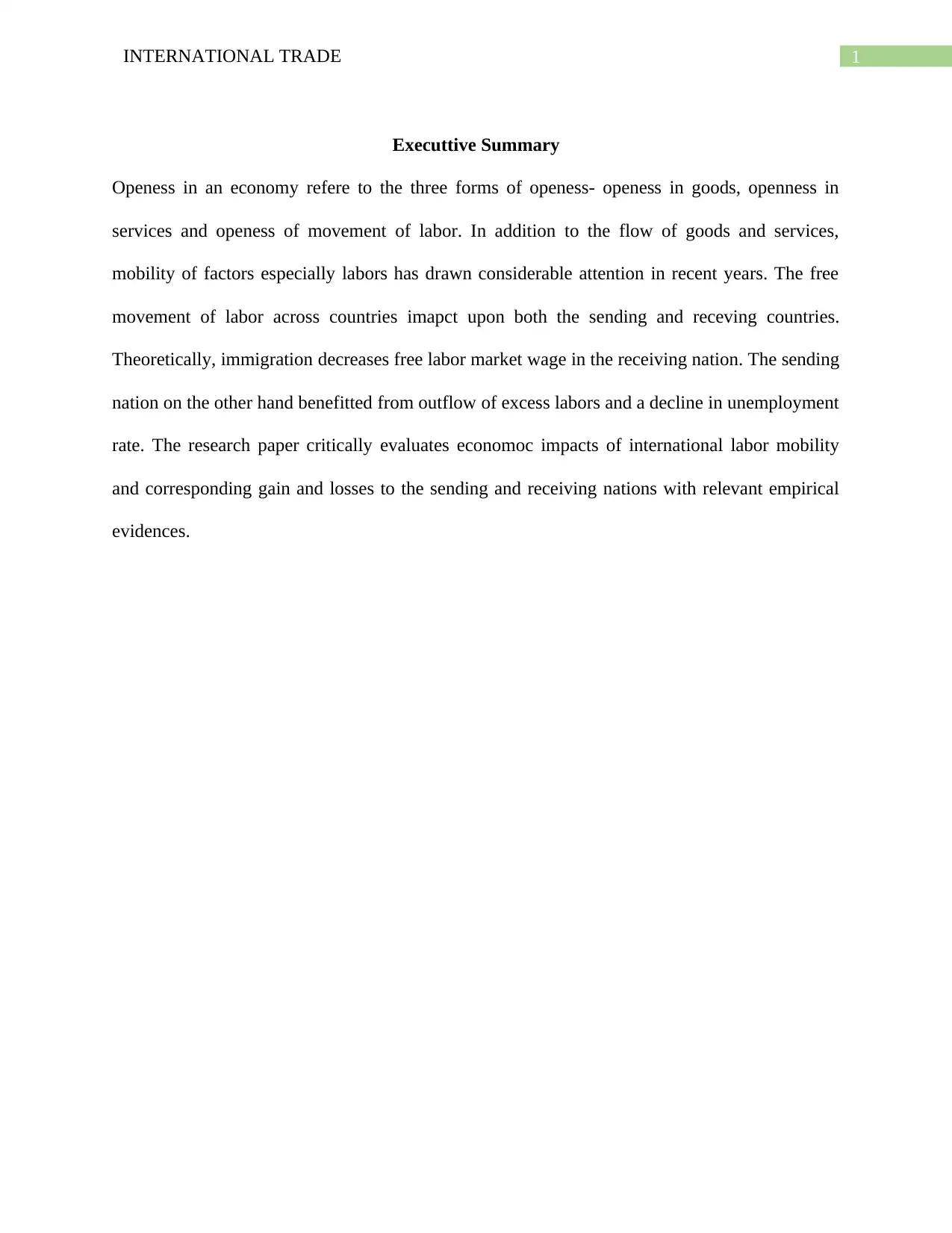
1INTERNATIONAL TRADE
Executtive Summary
Openess in an economy refere to the three forms of openess- openess in goods, openness in
services and openess of movement of labor. In addition to the flow of goods and services,
mobility of factors especially labors has drawn considerable attention in recent years. The free
movement of labor across countries imapct upon both the sending and receving countries.
Theoretically, immigration decreases free labor market wage in the receiving nation. The sending
nation on the other hand benefitted from outflow of excess labors and a decline in unemployment
rate. The research paper critically evaluates economoc impacts of international labor mobility
and corresponding gain and losses to the sending and receiving nations with relevant empirical
evidences.
Executtive Summary
Openess in an economy refere to the three forms of openess- openess in goods, openness in
services and openess of movement of labor. In addition to the flow of goods and services,
mobility of factors especially labors has drawn considerable attention in recent years. The free
movement of labor across countries imapct upon both the sending and receving countries.
Theoretically, immigration decreases free labor market wage in the receiving nation. The sending
nation on the other hand benefitted from outflow of excess labors and a decline in unemployment
rate. The research paper critically evaluates economoc impacts of international labor mobility
and corresponding gain and losses to the sending and receiving nations with relevant empirical
evidences.
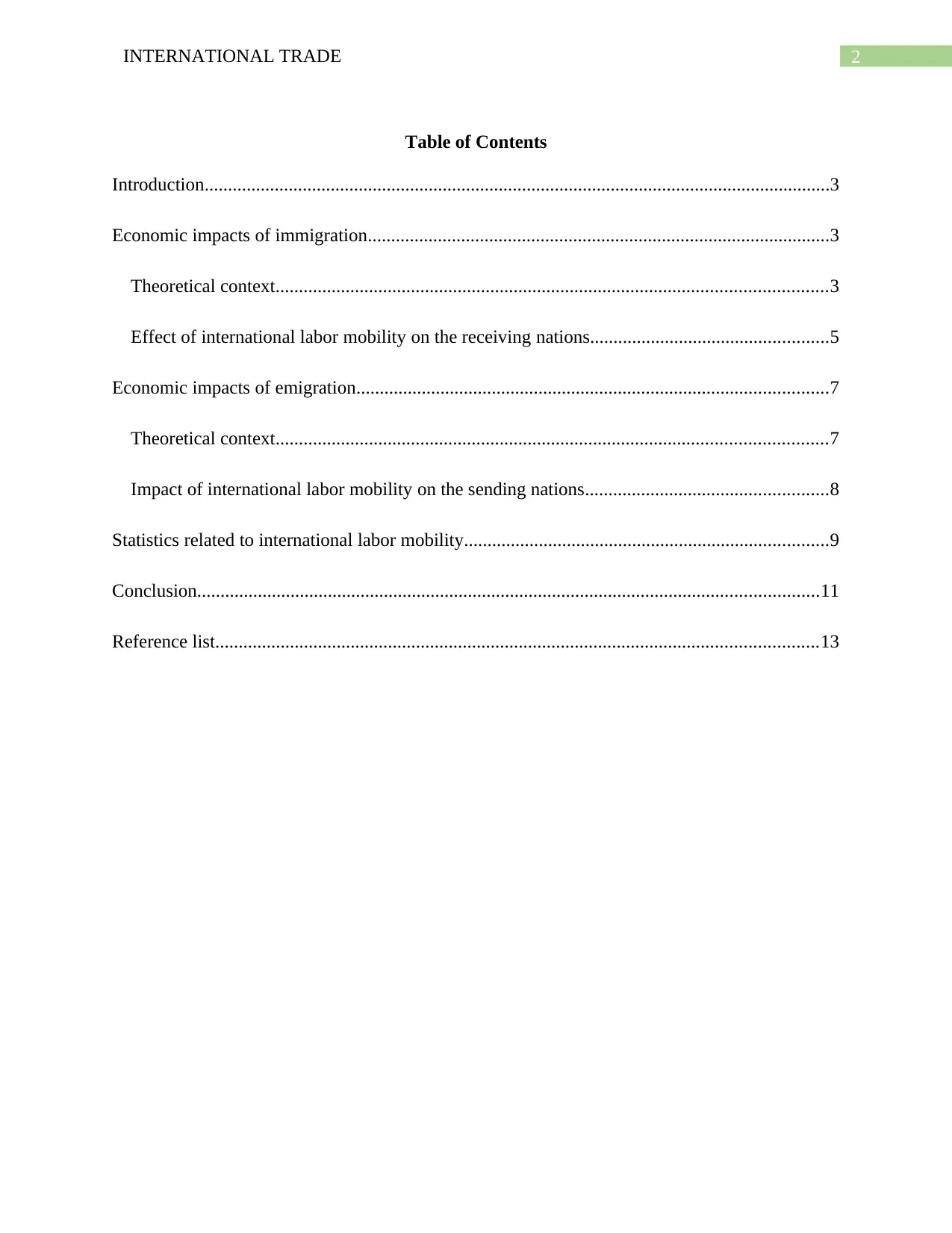
2INTERNATIONAL TRADE
Table of Contents
Introduction......................................................................................................................................3
Economic impacts of immigration...................................................................................................3
Theoretical context......................................................................................................................3
Effect of international labor mobility on the receiving nations...................................................5
Economic impacts of emigration.....................................................................................................7
Theoretical context......................................................................................................................7
Impact of international labor mobility on the sending nations....................................................8
Statistics related to international labor mobility..............................................................................9
Conclusion.....................................................................................................................................11
Reference list.................................................................................................................................13
Table of Contents
Introduction......................................................................................................................................3
Economic impacts of immigration...................................................................................................3
Theoretical context......................................................................................................................3
Effect of international labor mobility on the receiving nations...................................................5
Economic impacts of emigration.....................................................................................................7
Theoretical context......................................................................................................................7
Impact of international labor mobility on the sending nations....................................................8
Statistics related to international labor mobility..............................................................................9
Conclusion.....................................................................................................................................11
Reference list.................................................................................................................................13
⊘ This is a preview!⊘
Do you want full access?
Subscribe today to unlock all pages.

Trusted by 1+ million students worldwide
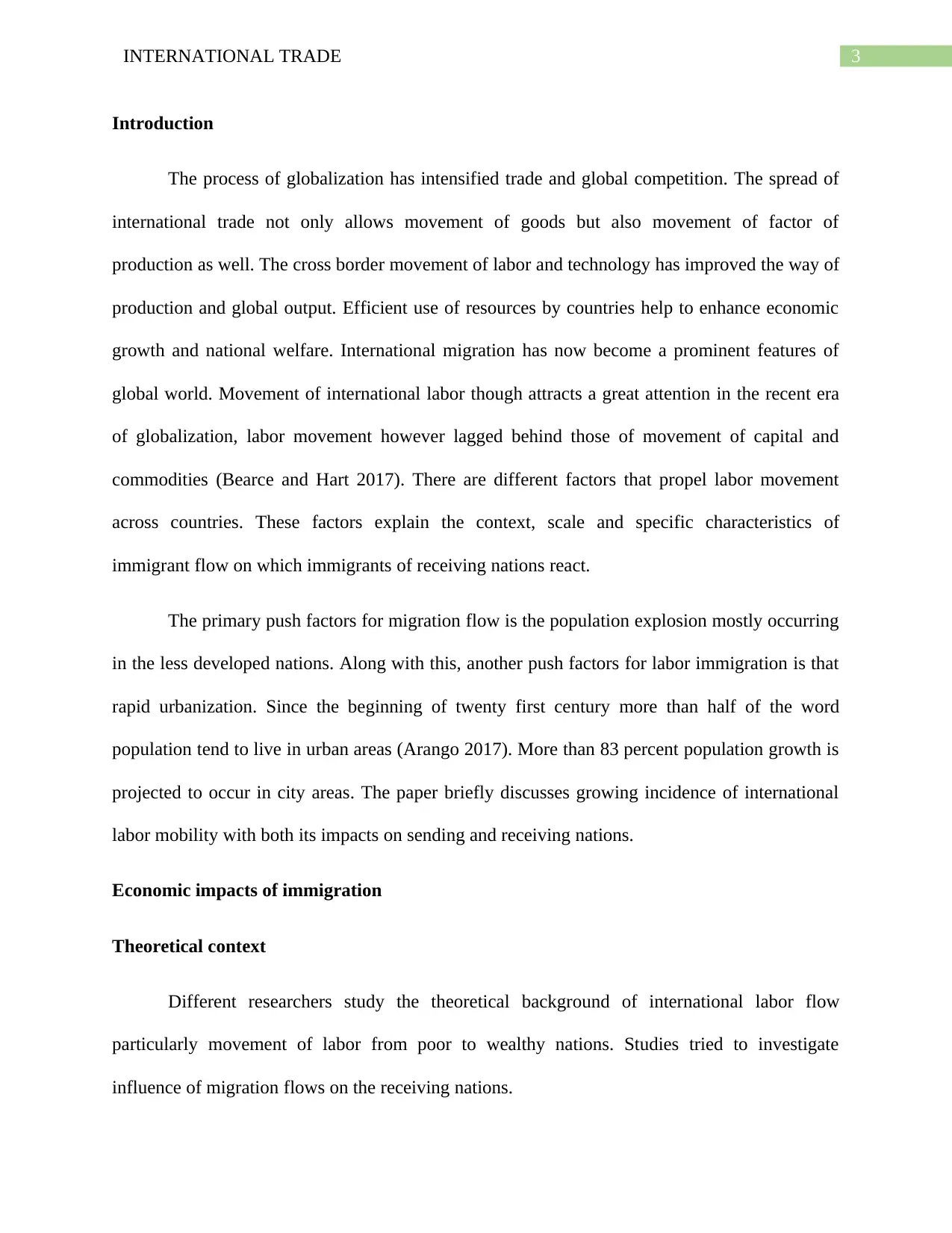
3INTERNATIONAL TRADE
Introduction
The process of globalization has intensified trade and global competition. The spread of
international trade not only allows movement of goods but also movement of factor of
production as well. The cross border movement of labor and technology has improved the way of
production and global output. Efficient use of resources by countries help to enhance economic
growth and national welfare. International migration has now become a prominent features of
global world. Movement of international labor though attracts a great attention in the recent era
of globalization, labor movement however lagged behind those of movement of capital and
commodities (Bearce and Hart 2017). There are different factors that propel labor movement
across countries. These factors explain the context, scale and specific characteristics of
immigrant flow on which immigrants of receiving nations react.
The primary push factors for migration flow is the population explosion mostly occurring
in the less developed nations. Along with this, another push factors for labor immigration is that
rapid urbanization. Since the beginning of twenty first century more than half of the word
population tend to live in urban areas (Arango 2017). More than 83 percent population growth is
projected to occur in city areas. The paper briefly discusses growing incidence of international
labor mobility with both its impacts on sending and receiving nations.
Economic impacts of immigration
Theoretical context
Different researchers study the theoretical background of international labor flow
particularly movement of labor from poor to wealthy nations. Studies tried to investigate
influence of migration flows on the receiving nations.
Introduction
The process of globalization has intensified trade and global competition. The spread of
international trade not only allows movement of goods but also movement of factor of
production as well. The cross border movement of labor and technology has improved the way of
production and global output. Efficient use of resources by countries help to enhance economic
growth and national welfare. International migration has now become a prominent features of
global world. Movement of international labor though attracts a great attention in the recent era
of globalization, labor movement however lagged behind those of movement of capital and
commodities (Bearce and Hart 2017). There are different factors that propel labor movement
across countries. These factors explain the context, scale and specific characteristics of
immigrant flow on which immigrants of receiving nations react.
The primary push factors for migration flow is the population explosion mostly occurring
in the less developed nations. Along with this, another push factors for labor immigration is that
rapid urbanization. Since the beginning of twenty first century more than half of the word
population tend to live in urban areas (Arango 2017). More than 83 percent population growth is
projected to occur in city areas. The paper briefly discusses growing incidence of international
labor mobility with both its impacts on sending and receiving nations.
Economic impacts of immigration
Theoretical context
Different researchers study the theoretical background of international labor flow
particularly movement of labor from poor to wealthy nations. Studies tried to investigate
influence of migration flows on the receiving nations.
Paraphrase This Document
Need a fresh take? Get an instant paraphrase of this document with our AI Paraphraser
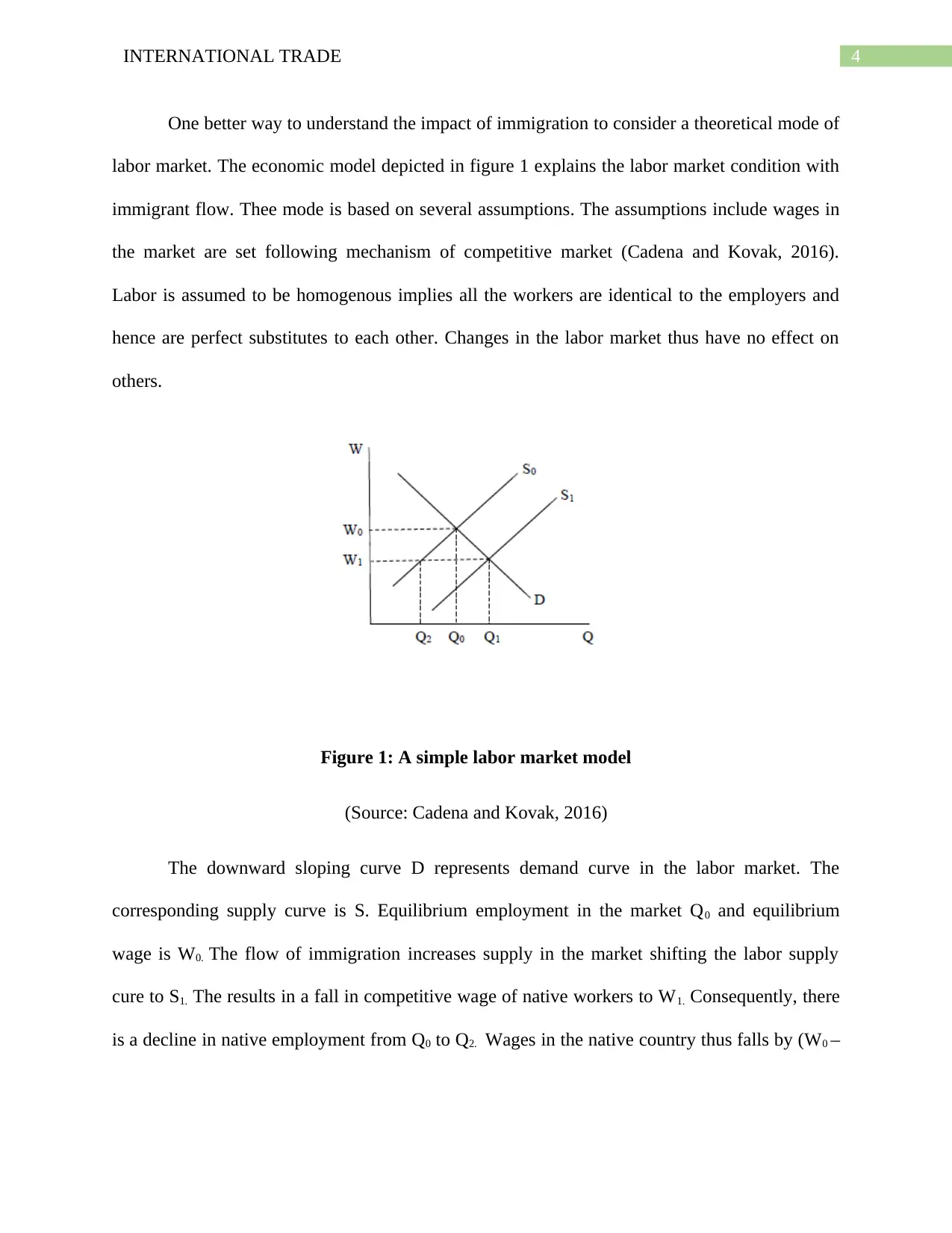
4INTERNATIONAL TRADE
One better way to understand the impact of immigration to consider a theoretical mode of
labor market. The economic model depicted in figure 1 explains the labor market condition with
immigrant flow. Thee mode is based on several assumptions. The assumptions include wages in
the market are set following mechanism of competitive market (Cadena and Kovak, 2016).
Labor is assumed to be homogenous implies all the workers are identical to the employers and
hence are perfect substitutes to each other. Changes in the labor market thus have no effect on
others.
Figure 1: A simple labor market model
(Source: Cadena and Kovak, 2016)
The downward sloping curve D represents demand curve in the labor market. The
corresponding supply curve is S. Equilibrium employment in the market Q0 and equilibrium
wage is W0. The flow of immigration increases supply in the market shifting the labor supply
cure to S1. The results in a fall in competitive wage of native workers to W1. Consequently, there
is a decline in native employment from Q0 to Q2. Wages in the native country thus falls by (W0 –
One better way to understand the impact of immigration to consider a theoretical mode of
labor market. The economic model depicted in figure 1 explains the labor market condition with
immigrant flow. Thee mode is based on several assumptions. The assumptions include wages in
the market are set following mechanism of competitive market (Cadena and Kovak, 2016).
Labor is assumed to be homogenous implies all the workers are identical to the employers and
hence are perfect substitutes to each other. Changes in the labor market thus have no effect on
others.
Figure 1: A simple labor market model
(Source: Cadena and Kovak, 2016)
The downward sloping curve D represents demand curve in the labor market. The
corresponding supply curve is S. Equilibrium employment in the market Q0 and equilibrium
wage is W0. The flow of immigration increases supply in the market shifting the labor supply
cure to S1. The results in a fall in competitive wage of native workers to W1. Consequently, there
is a decline in native employment from Q0 to Q2. Wages in the native country thus falls by (W0 –
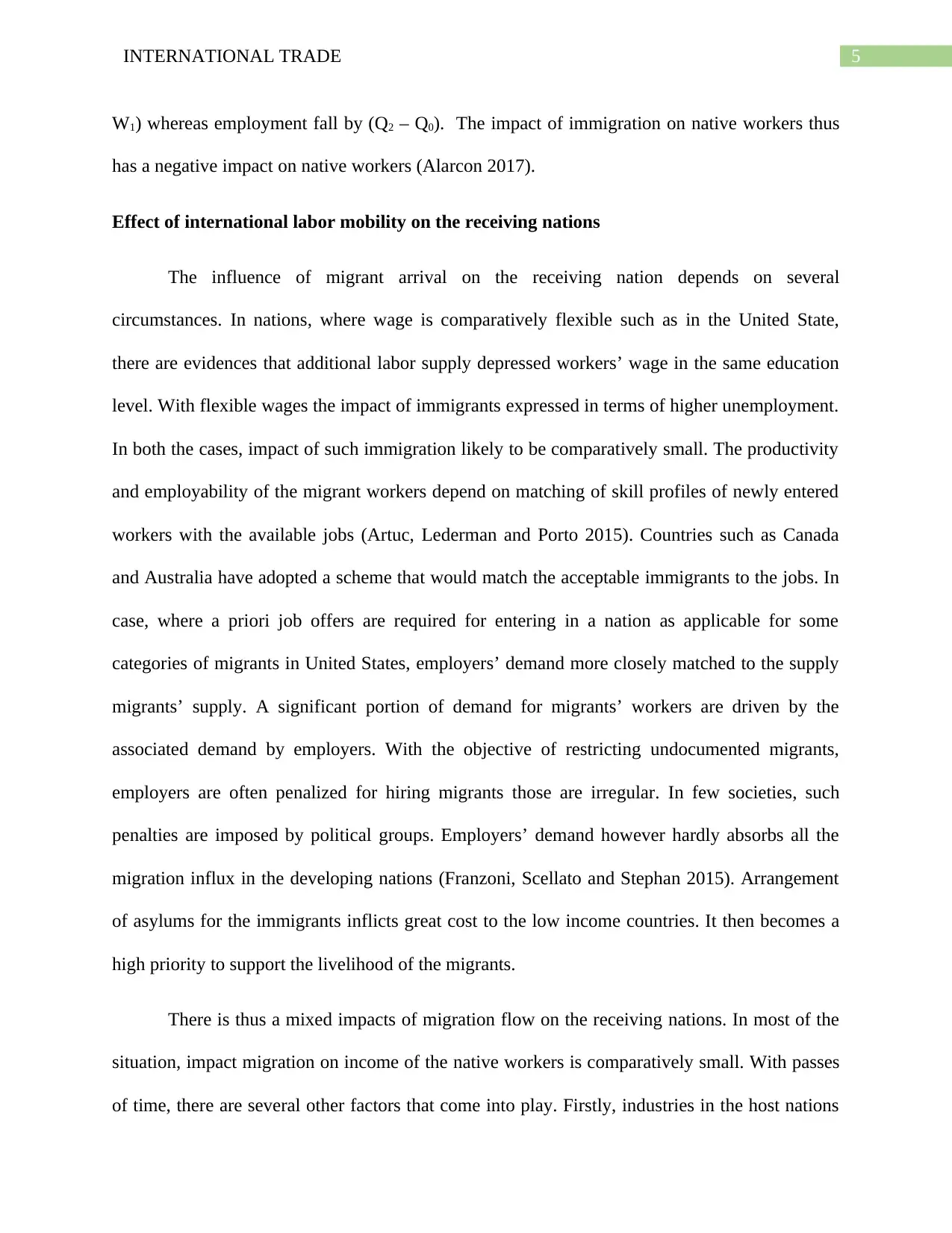
5INTERNATIONAL TRADE
W1) whereas employment fall by (Q2 – Q0). The impact of immigration on native workers thus
has a negative impact on native workers (Alarcon 2017).
Effect of international labor mobility on the receiving nations
The influence of migrant arrival on the receiving nation depends on several
circumstances. In nations, where wage is comparatively flexible such as in the United State,
there are evidences that additional labor supply depressed workers’ wage in the same education
level. With flexible wages the impact of immigrants expressed in terms of higher unemployment.
In both the cases, impact of such immigration likely to be comparatively small. The productivity
and employability of the migrant workers depend on matching of skill profiles of newly entered
workers with the available jobs (Artuc, Lederman and Porto 2015). Countries such as Canada
and Australia have adopted a scheme that would match the acceptable immigrants to the jobs. In
case, where a priori job offers are required for entering in a nation as applicable for some
categories of migrants in United States, employers’ demand more closely matched to the supply
migrants’ supply. A significant portion of demand for migrants’ workers are driven by the
associated demand by employers. With the objective of restricting undocumented migrants,
employers are often penalized for hiring migrants those are irregular. In few societies, such
penalties are imposed by political groups. Employers’ demand however hardly absorbs all the
migration influx in the developing nations (Franzoni, Scellato and Stephan 2015). Arrangement
of asylums for the immigrants inflicts great cost to the low income countries. It then becomes a
high priority to support the livelihood of the migrants.
There is thus a mixed impacts of migration flow on the receiving nations. In most of the
situation, impact migration on income of the native workers is comparatively small. With passes
of time, there are several other factors that come into play. Firstly, industries in the host nations
W1) whereas employment fall by (Q2 – Q0). The impact of immigration on native workers thus
has a negative impact on native workers (Alarcon 2017).
Effect of international labor mobility on the receiving nations
The influence of migrant arrival on the receiving nation depends on several
circumstances. In nations, where wage is comparatively flexible such as in the United State,
there are evidences that additional labor supply depressed workers’ wage in the same education
level. With flexible wages the impact of immigrants expressed in terms of higher unemployment.
In both the cases, impact of such immigration likely to be comparatively small. The productivity
and employability of the migrant workers depend on matching of skill profiles of newly entered
workers with the available jobs (Artuc, Lederman and Porto 2015). Countries such as Canada
and Australia have adopted a scheme that would match the acceptable immigrants to the jobs. In
case, where a priori job offers are required for entering in a nation as applicable for some
categories of migrants in United States, employers’ demand more closely matched to the supply
migrants’ supply. A significant portion of demand for migrants’ workers are driven by the
associated demand by employers. With the objective of restricting undocumented migrants,
employers are often penalized for hiring migrants those are irregular. In few societies, such
penalties are imposed by political groups. Employers’ demand however hardly absorbs all the
migration influx in the developing nations (Franzoni, Scellato and Stephan 2015). Arrangement
of asylums for the immigrants inflicts great cost to the low income countries. It then becomes a
high priority to support the livelihood of the migrants.
There is thus a mixed impacts of migration flow on the receiving nations. In most of the
situation, impact migration on income of the native workers is comparatively small. With passes
of time, there are several other factors that come into play. Firstly, industries in the host nations
⊘ This is a preview!⊘
Do you want full access?
Subscribe today to unlock all pages.

Trusted by 1+ million students worldwide
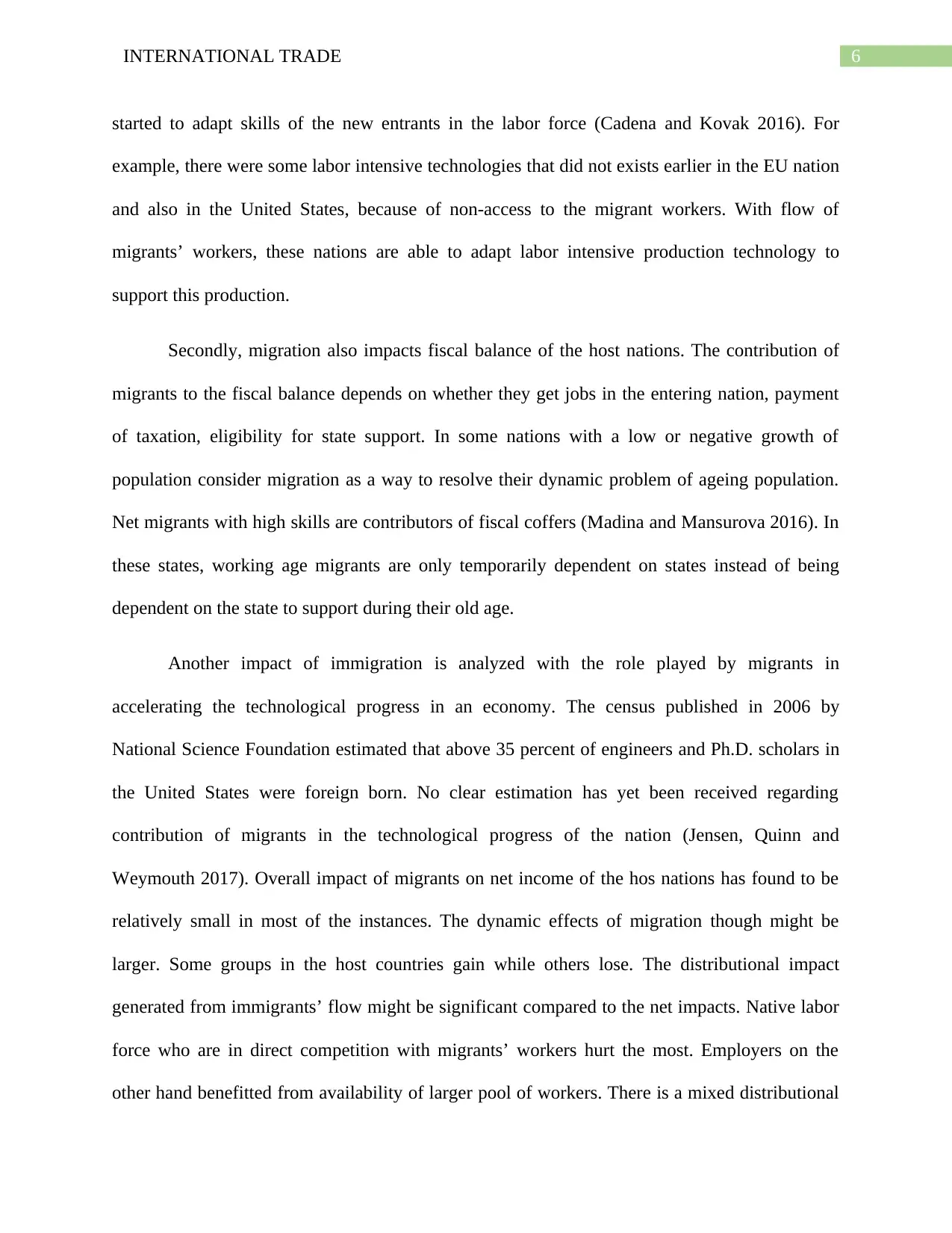
6INTERNATIONAL TRADE
started to adapt skills of the new entrants in the labor force (Cadena and Kovak 2016). For
example, there were some labor intensive technologies that did not exists earlier in the EU nation
and also in the United States, because of non-access to the migrant workers. With flow of
migrants’ workers, these nations are able to adapt labor intensive production technology to
support this production.
Secondly, migration also impacts fiscal balance of the host nations. The contribution of
migrants to the fiscal balance depends on whether they get jobs in the entering nation, payment
of taxation, eligibility for state support. In some nations with a low or negative growth of
population consider migration as a way to resolve their dynamic problem of ageing population.
Net migrants with high skills are contributors of fiscal coffers (Madina and Mansurova 2016). In
these states, working age migrants are only temporarily dependent on states instead of being
dependent on the state to support during their old age.
Another impact of immigration is analyzed with the role played by migrants in
accelerating the technological progress in an economy. The census published in 2006 by
National Science Foundation estimated that above 35 percent of engineers and Ph.D. scholars in
the United States were foreign born. No clear estimation has yet been received regarding
contribution of migrants in the technological progress of the nation (Jensen, Quinn and
Weymouth 2017). Overall impact of migrants on net income of the hos nations has found to be
relatively small in most of the instances. The dynamic effects of migration though might be
larger. Some groups in the host countries gain while others lose. The distributional impact
generated from immigrants’ flow might be significant compared to the net impacts. Native labor
force who are in direct competition with migrants’ workers hurt the most. Employers on the
other hand benefitted from availability of larger pool of workers. There is a mixed distributional
started to adapt skills of the new entrants in the labor force (Cadena and Kovak 2016). For
example, there were some labor intensive technologies that did not exists earlier in the EU nation
and also in the United States, because of non-access to the migrant workers. With flow of
migrants’ workers, these nations are able to adapt labor intensive production technology to
support this production.
Secondly, migration also impacts fiscal balance of the host nations. The contribution of
migrants to the fiscal balance depends on whether they get jobs in the entering nation, payment
of taxation, eligibility for state support. In some nations with a low or negative growth of
population consider migration as a way to resolve their dynamic problem of ageing population.
Net migrants with high skills are contributors of fiscal coffers (Madina and Mansurova 2016). In
these states, working age migrants are only temporarily dependent on states instead of being
dependent on the state to support during their old age.
Another impact of immigration is analyzed with the role played by migrants in
accelerating the technological progress in an economy. The census published in 2006 by
National Science Foundation estimated that above 35 percent of engineers and Ph.D. scholars in
the United States were foreign born. No clear estimation has yet been received regarding
contribution of migrants in the technological progress of the nation (Jensen, Quinn and
Weymouth 2017). Overall impact of migrants on net income of the hos nations has found to be
relatively small in most of the instances. The dynamic effects of migration though might be
larger. Some groups in the host countries gain while others lose. The distributional impact
generated from immigrants’ flow might be significant compared to the net impacts. Native labor
force who are in direct competition with migrants’ workers hurt the most. Employers on the
other hand benefitted from availability of larger pool of workers. There is a mixed distributional
Paraphrase This Document
Need a fresh take? Get an instant paraphrase of this document with our AI Paraphraser
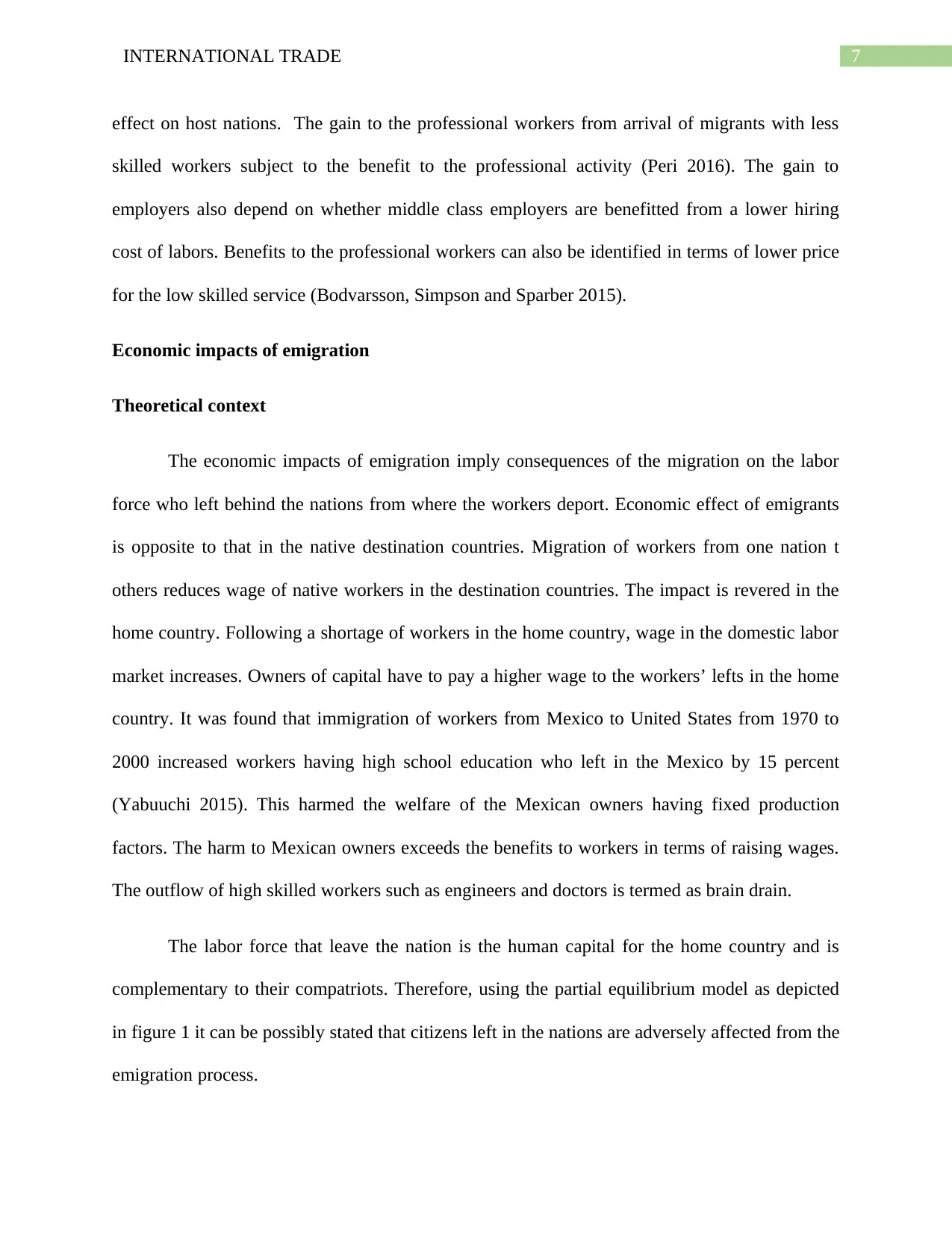
7INTERNATIONAL TRADE
effect on host nations. The gain to the professional workers from arrival of migrants with less
skilled workers subject to the benefit to the professional activity (Peri 2016). The gain to
employers also depend on whether middle class employers are benefitted from a lower hiring
cost of labors. Benefits to the professional workers can also be identified in terms of lower price
for the low skilled service (Bodvarsson, Simpson and Sparber 2015).
Economic impacts of emigration
Theoretical context
The economic impacts of emigration imply consequences of the migration on the labor
force who left behind the nations from where the workers deport. Economic effect of emigrants
is opposite to that in the native destination countries. Migration of workers from one nation t
others reduces wage of native workers in the destination countries. The impact is revered in the
home country. Following a shortage of workers in the home country, wage in the domestic labor
market increases. Owners of capital have to pay a higher wage to the workers’ lefts in the home
country. It was found that immigration of workers from Mexico to United States from 1970 to
2000 increased workers having high school education who left in the Mexico by 15 percent
(Yabuuchi 2015). This harmed the welfare of the Mexican owners having fixed production
factors. The harm to Mexican owners exceeds the benefits to workers in terms of raising wages.
The outflow of high skilled workers such as engineers and doctors is termed as brain drain.
The labor force that leave the nation is the human capital for the home country and is
complementary to their compatriots. Therefore, using the partial equilibrium model as depicted
in figure 1 it can be possibly stated that citizens left in the nations are adversely affected from the
emigration process.
effect on host nations. The gain to the professional workers from arrival of migrants with less
skilled workers subject to the benefit to the professional activity (Peri 2016). The gain to
employers also depend on whether middle class employers are benefitted from a lower hiring
cost of labors. Benefits to the professional workers can also be identified in terms of lower price
for the low skilled service (Bodvarsson, Simpson and Sparber 2015).
Economic impacts of emigration
Theoretical context
The economic impacts of emigration imply consequences of the migration on the labor
force who left behind the nations from where the workers deport. Economic effect of emigrants
is opposite to that in the native destination countries. Migration of workers from one nation t
others reduces wage of native workers in the destination countries. The impact is revered in the
home country. Following a shortage of workers in the home country, wage in the domestic labor
market increases. Owners of capital have to pay a higher wage to the workers’ lefts in the home
country. It was found that immigration of workers from Mexico to United States from 1970 to
2000 increased workers having high school education who left in the Mexico by 15 percent
(Yabuuchi 2015). This harmed the welfare of the Mexican owners having fixed production
factors. The harm to Mexican owners exceeds the benefits to workers in terms of raising wages.
The outflow of high skilled workers such as engineers and doctors is termed as brain drain.
The labor force that leave the nation is the human capital for the home country and is
complementary to their compatriots. Therefore, using the partial equilibrium model as depicted
in figure 1 it can be possibly stated that citizens left in the nations are adversely affected from the
emigration process.

8INTERNATIONAL TRADE
⊘ This is a preview!⊘
Do you want full access?
Subscribe today to unlock all pages.

Trusted by 1+ million students worldwide
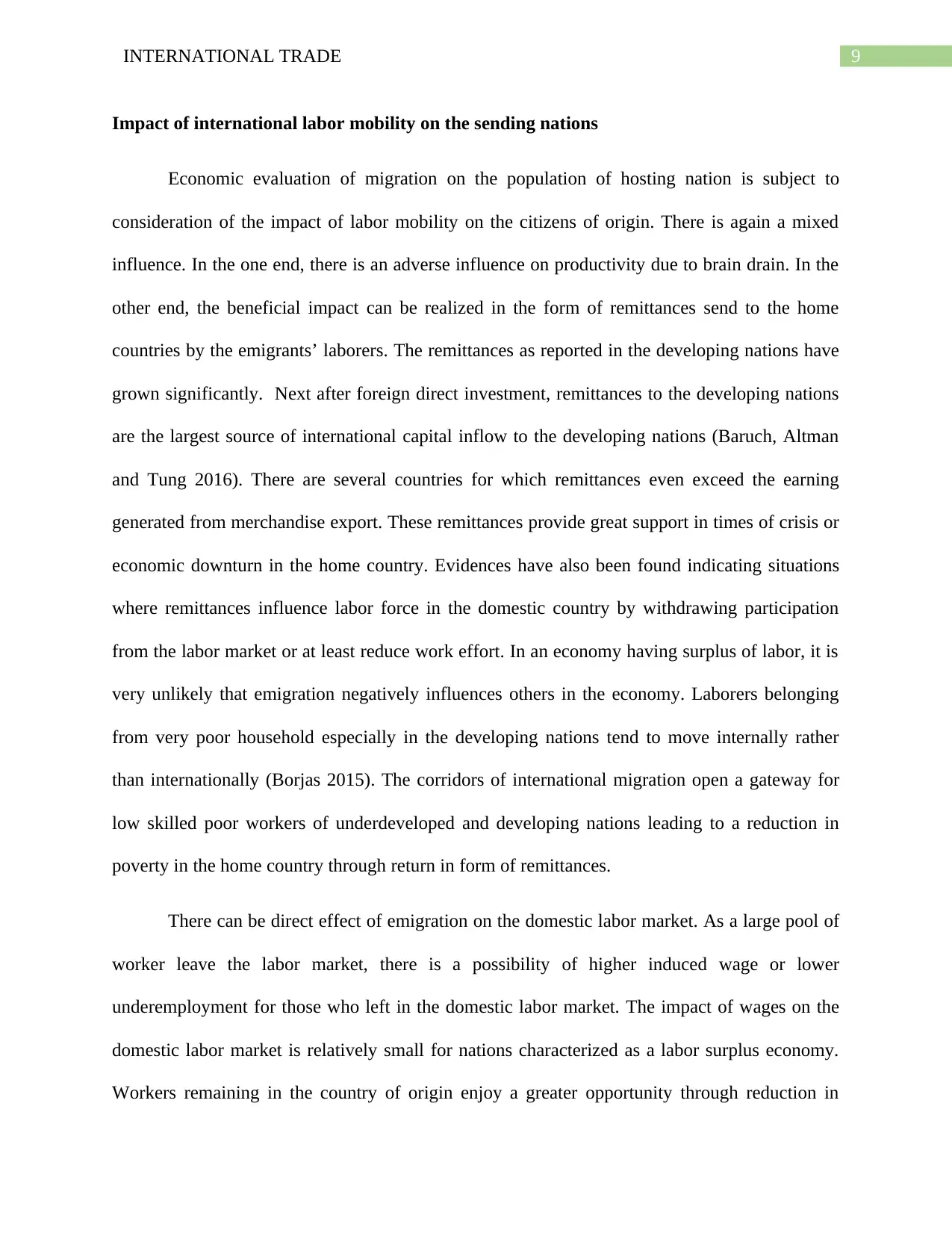
9INTERNATIONAL TRADE
Impact of international labor mobility on the sending nations
Economic evaluation of migration on the population of hosting nation is subject to
consideration of the impact of labor mobility on the citizens of origin. There is again a mixed
influence. In the one end, there is an adverse influence on productivity due to brain drain. In the
other end, the beneficial impact can be realized in the form of remittances send to the home
countries by the emigrants’ laborers. The remittances as reported in the developing nations have
grown significantly. Next after foreign direct investment, remittances to the developing nations
are the largest source of international capital inflow to the developing nations (Baruch, Altman
and Tung 2016). There are several countries for which remittances even exceed the earning
generated from merchandise export. These remittances provide great support in times of crisis or
economic downturn in the home country. Evidences have also been found indicating situations
where remittances influence labor force in the domestic country by withdrawing participation
from the labor market or at least reduce work effort. In an economy having surplus of labor, it is
very unlikely that emigration negatively influences others in the economy. Laborers belonging
from very poor household especially in the developing nations tend to move internally rather
than internationally (Borjas 2015). The corridors of international migration open a gateway for
low skilled poor workers of underdeveloped and developing nations leading to a reduction in
poverty in the home country through return in form of remittances.
There can be direct effect of emigration on the domestic labor market. As a large pool of
worker leave the labor market, there is a possibility of higher induced wage or lower
underemployment for those who left in the domestic labor market. The impact of wages on the
domestic labor market is relatively small for nations characterized as a labor surplus economy.
Workers remaining in the country of origin enjoy a greater opportunity through reduction in
Impact of international labor mobility on the sending nations
Economic evaluation of migration on the population of hosting nation is subject to
consideration of the impact of labor mobility on the citizens of origin. There is again a mixed
influence. In the one end, there is an adverse influence on productivity due to brain drain. In the
other end, the beneficial impact can be realized in the form of remittances send to the home
countries by the emigrants’ laborers. The remittances as reported in the developing nations have
grown significantly. Next after foreign direct investment, remittances to the developing nations
are the largest source of international capital inflow to the developing nations (Baruch, Altman
and Tung 2016). There are several countries for which remittances even exceed the earning
generated from merchandise export. These remittances provide great support in times of crisis or
economic downturn in the home country. Evidences have also been found indicating situations
where remittances influence labor force in the domestic country by withdrawing participation
from the labor market or at least reduce work effort. In an economy having surplus of labor, it is
very unlikely that emigration negatively influences others in the economy. Laborers belonging
from very poor household especially in the developing nations tend to move internally rather
than internationally (Borjas 2015). The corridors of international migration open a gateway for
low skilled poor workers of underdeveloped and developing nations leading to a reduction in
poverty in the home country through return in form of remittances.
There can be direct effect of emigration on the domestic labor market. As a large pool of
worker leave the labor market, there is a possibility of higher induced wage or lower
underemployment for those who left in the domestic labor market. The impact of wages on the
domestic labor market is relatively small for nations characterized as a labor surplus economy.
Workers remaining in the country of origin enjoy a greater opportunity through reduction in
Paraphrase This Document
Need a fresh take? Get an instant paraphrase of this document with our AI Paraphraser
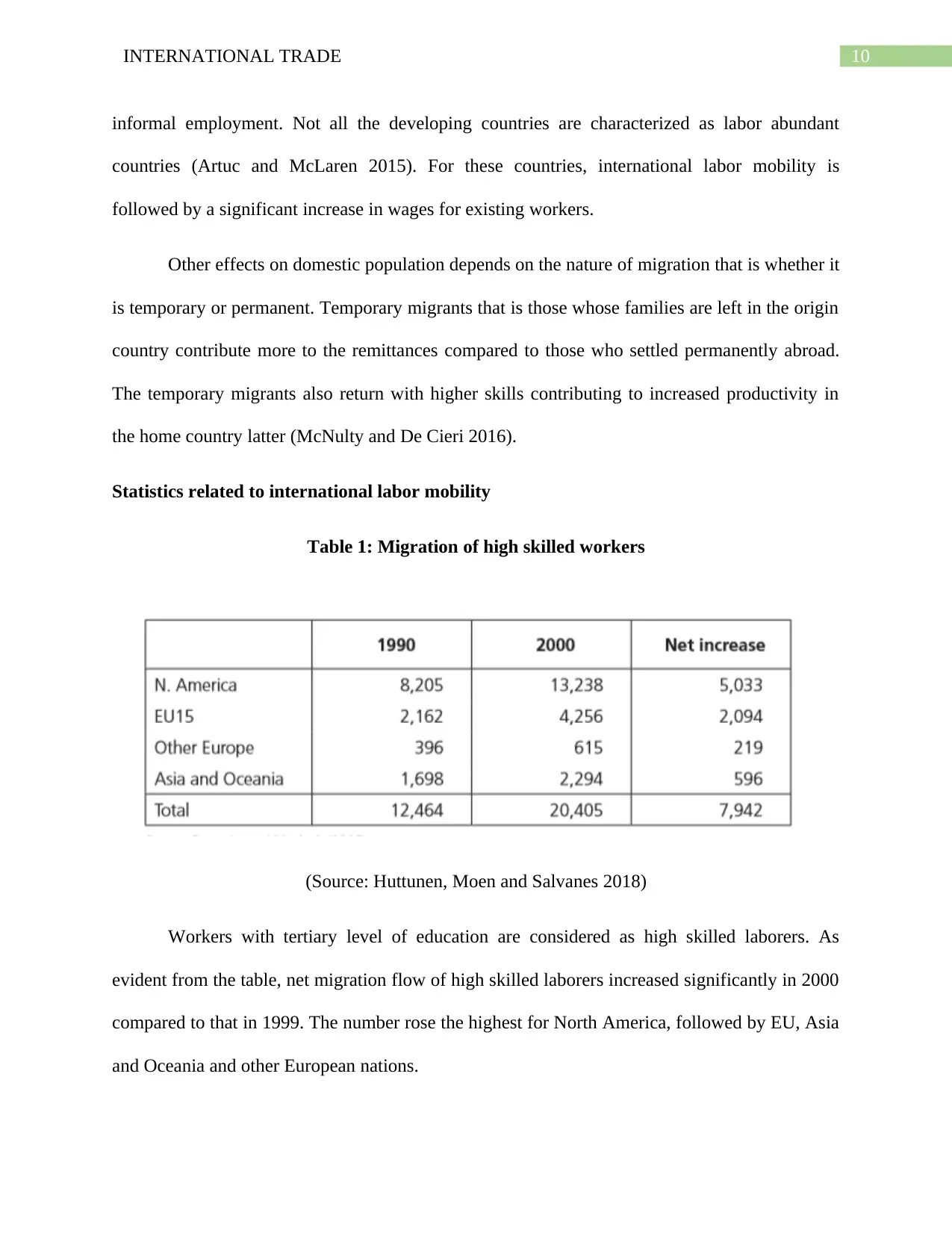
10INTERNATIONAL TRADE
informal employment. Not all the developing countries are characterized as labor abundant
countries (Artuc and McLaren 2015). For these countries, international labor mobility is
followed by a significant increase in wages for existing workers.
Other effects on domestic population depends on the nature of migration that is whether it
is temporary or permanent. Temporary migrants that is those whose families are left in the origin
country contribute more to the remittances compared to those who settled permanently abroad.
The temporary migrants also return with higher skills contributing to increased productivity in
the home country latter (McNulty and De Cieri 2016).
Statistics related to international labor mobility
Table 1: Migration of high skilled workers
(Source: Huttunen, Moen and Salvanes 2018)
Workers with tertiary level of education are considered as high skilled laborers. As
evident from the table, net migration flow of high skilled laborers increased significantly in 2000
compared to that in 1999. The number rose the highest for North America, followed by EU, Asia
and Oceania and other European nations.
informal employment. Not all the developing countries are characterized as labor abundant
countries (Artuc and McLaren 2015). For these countries, international labor mobility is
followed by a significant increase in wages for existing workers.
Other effects on domestic population depends on the nature of migration that is whether it
is temporary or permanent. Temporary migrants that is those whose families are left in the origin
country contribute more to the remittances compared to those who settled permanently abroad.
The temporary migrants also return with higher skills contributing to increased productivity in
the home country latter (McNulty and De Cieri 2016).
Statistics related to international labor mobility
Table 1: Migration of high skilled workers
(Source: Huttunen, Moen and Salvanes 2018)
Workers with tertiary level of education are considered as high skilled laborers. As
evident from the table, net migration flow of high skilled laborers increased significantly in 2000
compared to that in 1999. The number rose the highest for North America, followed by EU, Asia
and Oceania and other European nations.

11INTERNATIONAL TRADE
⊘ This is a preview!⊘
Do you want full access?
Subscribe today to unlock all pages.

Trusted by 1+ million students worldwide
1 out of 16
Related Documents
Your All-in-One AI-Powered Toolkit for Academic Success.
+13062052269
info@desklib.com
Available 24*7 on WhatsApp / Email
![[object Object]](/_next/static/media/star-bottom.7253800d.svg)
Unlock your academic potential
Copyright © 2020–2025 A2Z Services. All Rights Reserved. Developed and managed by ZUCOL.




